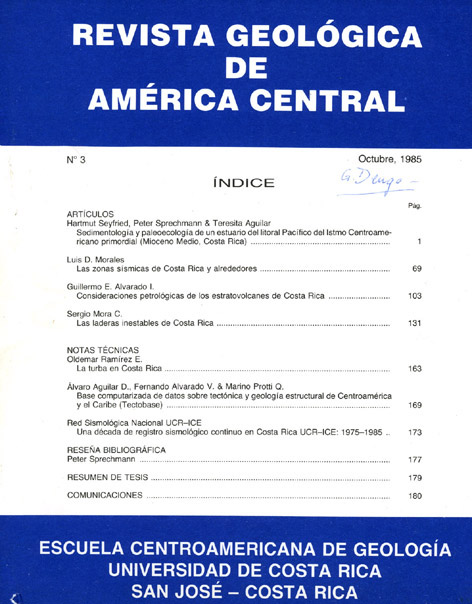Abstract
The rise of the Central American landbridge is characterized by a Campanian to Eocene island arc stage, an Oligocene to Miocene swell stage, and a Pliocene to Recent mountain chain stage. During the Oligocene to Miocene swell stage the volcanic edifices and insular shelves of the foregoing stage gradually grew together, forming the primordial Central American isthmus. Thus, extensive tidal flat areas established which occupied, especially during the Middle Miocene, large areas of the actual territory of Costa Rica. The present study deals with a Middle Miocene section situated at Punta Judas on the Pacific coast of Costa Rica. This section provides a nearly complete record of the depositional environments that characterize the Pacific estuaries of the primordial Central American isthmus. The 1300 m of mainly litharenitic volcaniclastic sediments are extre-mely fossiliferous, especially in mollusks, echinoids, and trace fossils. Thus, sedimentological interpretations can be choroughly controlled and complemented by paleoecological data. 10 different facies types could be identified that reflect a great variety of depositional environments ranging from open estuary through intertidal shoals and mangrove swamps to mesohaline marginal shallows, and even slightly hypersaline lagoons. Facies character and pattern in the subtidal area was largely controlled by the temporariness and volume of the terrigenous input which was transferred across the deltaic depocenter and overtaken by the estuarine circulatory regime Ecological successions that developped in response to the intermittent sediment supnlv commonly are characterized by native background communities (susnenpion feeiers - mollusks) and opportunistic after-event communities (sediment feeders-cetossils) senau SEILACHER (1980). In the intertidal area lower flats are typified by crosslaminated sand-stones, whereas in mid and upper flats mangrove swamp deposits are predominant. This fades unit frequently interfingers with granule and pebble conglomerates that entered from minor lateral river mouths. The coarse river bed load. is redistributed both in meandering tidal channels and in straight beach-parallel channels. The latter show an unidirecional filling pattern, the size ranges being fashioned into large graded sigmoidal foresets that end up in welldevelopped toe sets; mud drapes prove that these features have to be considered as ti, dal bundles. Tempestites are fairly frequent within the mangrove swamp deposits, but occur also in nearly all other facies types. Following these criteria it mustbe concluded that the Punta Judas estuary was laterally bounded by a mountainous hinterland and headed by a stream system that supplied large amounts of fine- to medium-sized volcaniclastic sediments. Despite the low salinities in its uppermost sector, the estuary was strongly controlled by esotidal currents which obviously followed an asymmetrical circulatory pattern. It was an essentially sandy estuary and must have reached dimension, comparable to the actual Gulf of Nicoya. There is no evidence for the existence of an outer bar, of barrier islands, or ebb- and flood-tidal deltas. Hence, thp Middlo Miocene Punta Judas estuary has to be considered as an open embayment. The Punta Judas section documents at least 2 complete filling cycles (pro-gradations). The return from shoreline to open estuarine environments always came off very abruptly. This suggests rapid sealevel rises, followed by gra-dual lowerings. The absence of both angular unconformities and hardgrounds proves that subsidence was fairly constant. Most probably, the Punta Judas estuarine embayment was a direct graben-like tectonic feature. These data coincide with the tectonical and geographical framework of the actual Pacific estuaries of Central America. Differences exist, however, in that the Punta Judas estuary reached salinities as low as the -mesohaline range. This is not common to the actual ones which are essentially normal marine to high polyhaline. Thus, we propose an environmental model which falls midway bet-ween the strongly tectonically controlled Pacific centroamerican type and the epicontinental type which characterizes mid latitude Atlantic coastal plains.Comments
Downloads
Download data is not yet available.






